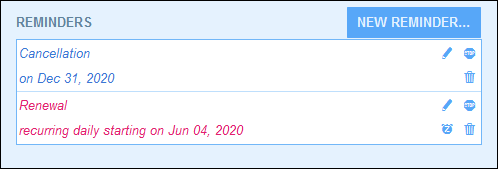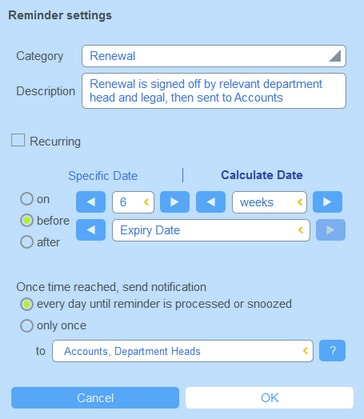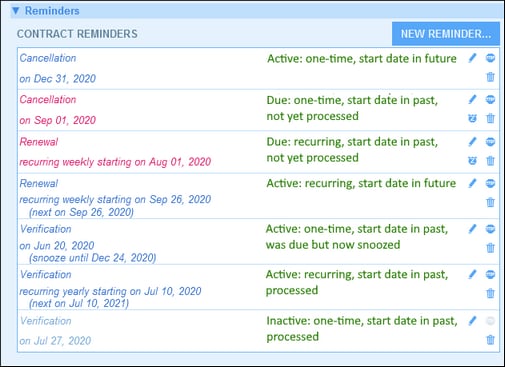User Actions (User)
Reminders and reminder emails are configured by system administrators. However, users have the final decision about what reminders are sent, when, and to whom. Users can manage reminders by deleting or modifying reminders and by creating new reminders. Typically, access to reminders will be made available to users in a form, such as an entry form. The screenshot below, for example, shows part of a data entry form for contracts.

A user can do the following:
•Add a new reminder or edit an existing reminder. Clicking either of these commands takes the user to the Reminder Settings form, where the reminder can be configured (see below).
•The user can snooze an existing due reminder. See Status of Reminders below.
•The user can stop a reminder (which is equivalent to marking the reminder as processed). See Status of Reminders below.
•The user can delete a reminder.
Icons for reminder management
Edit Reminder | |
Snooze Reminder | |
Stop Reminder | |
Delete Reminder |
Reminder settings
The Reminder Settings form is shown below.
Define the reminder with the following settings:
•Category: Select the category of the reminder. Reminder categories were defined when the reminder field was configured.
•Description: Provide a description to help users to understand how this reminder will apply.
•Recurring: Select this option to define the reminder as a recurring reminder. A recurrence is defined in terms of a period that follows a selected date. For example, a reminder can recur monthly after the selected date. Also see Status of Reminders below.
•Reminder start time: There are two alternatives: (i) Select a specific date; or (ii) Calculate a date relative to one of the record's date fields (such as an expiry date). In the screenshot above, for example, the start time has been set to one week before the date in the Expiry Date field.
•Notification frequency: Send email notifications every day till the reminder is processed or snoozed by the user, or send email notifications once only. Also see Status of Reminders below.
•Notification recipients: Specify the alert groups to which notifications about this reminder will be sent. If no group is specified, then no recipient is selected. Note, however, that alert groups can also be chosen via filters (see next list item also).
•Add to new records: This setting is available only when an administrator is configuring a reminder field; it is not available to users when they are editing records. You can choose whether to add the current reminder to all new records or only to records to which the selected filter applies. For example, in the case of the screenshot above, the reminder will be added only for those records where an Expiry Date field value exists (which is what is defined in the Has Expiry Date filter). Note that if this filter has alert groups defined for it, then notifications will be sent to users of these alert groups.
Status of reminders
The status of reminders is defined in the following terms (also see screenshot below, which assumes a current date of 16 September 2020):
•Start date: The date from which the reminder becomes active. If the start date is in the past, then the reminder stays active if: (i) it is not processed, or (ii) it recurs. If the start date is in the future, then the reminder is an active reminder.
•A processed reminder is one for which the reminded event has been carried out and because of which the reminder has been stopped.
•Action date: (i) For one-time reminders, the same as the start date: (ii) For recurring reminders, the next recurring date after a reminder is processed. An action date can lie in the past or in the future.
•Active reminder: (i) A one-time reminder that has a start date in the past and which has not been processed; (ii) A recurring reminder that has a start date in the past (and may have been processed); (iii) (i) A reminder (one-time or recurring) that has a start date in the future. (Note: If the action date of an active reminder is in the past and the reminder has not been processed, then the reminder is a due reminder.)
•Due reminder: An active reminder with a start date in the past. Due reminders are a subset of active reminders. Once a reminder becomes due, the possibility to snooze the reminder becomes available.
•A snoozed reminder applies to due reminders only. Snoozing a reminder cancels the current action date and selects an action date in the future. The snooze period is specified from the current date.
•Inactive reminder: A non-recurring reminder which has a start date in the past and which has been processed.
Color codes indicate reminder status
During data entry, the text color of reminders indicate their status to the user:
•Blue: Active reminders that are not due reminders
•Red: Due reminders
•Gray: Inactive reminders
Debugging reminder email errors
If reminder emails are not being correctly sent, check the following:
•Check whether emails have been set to be sent to the intended alert group/s. If yes, then check (with your system administrator) that users belong to the correct alert groups. Note that alert groups can be selected in two ways: (i) directly in the reminder's settings, and (ii) via the alert groups defined for a filter that the reminder is using. If there is a problem, contact your system administrator.
•Check that the reminder settings are correct.
•Check that the reminder is a due reminder; if the reminder has any other status, no email will be sent

